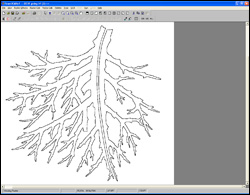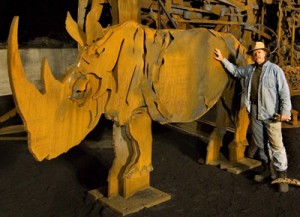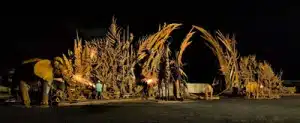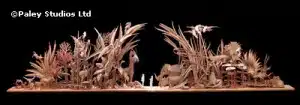Celebrated American metal sculptor Albert Paley used Scan2CAD raster to vector conversion software to transform hundreds of paper patterns of animals and plants into CNC profiles for his imposing, new 100-ton Cor-ten weathered steel sculpture, “Animals Always”, at the St Louis Zoo, MO.
“Animals Always” is the world’s largest public zoo sculpture. It contains more than 60 recognizable animals, including elephants, penguins, giraffes and a giant salamander, as well as exotic vegetation. Measuring 130 feet long, 36 feet high and 8 feet deep, the sculpture sits in a new plaza and dominates the zoo’s southeast corner, making a welcoming new entrance to the St Louis Zoo and Forest Park.
“It’s about how we relate to a threatened environment,” said Paley, now arguably America’s foremost forged metal sculptor. Paley is celebrated worldwide for his inventive approach to form development and metal technique. He is currently a Distinguished Professor holding the Charlotte Fredericks Mowris endowed chair at the College of Imaging Arts and Sciences at the Rochester Institute of Technology.
Paley developed the original design concept for “Animals Always” over 20 years ago. The current design is the result of an inspirational architectural tour of St Louis and from working closely with St Louis Zoo authorities and others to develop the concept over the last three years. The scale and involvement of the St Louis Zoo sculpture is the largest and most complex project of his prolific career.
“I’m glad to be associated with the zoo which is involved with many international programs to save endangered species,” Paley said. “I went to zoos including the Seneca Park Zoo and drew a lot of animals. The challenge was personalizing these animal designs. I love challenges, but this has been a huge undertaking”.
Working initially from paper sketches Paley used these to create cardboard models for the fabrication of the sculpture. Animals Always” has more than 1,300 parts. The cardboard models alone took Paley six months. His problem lay in converting the cardboard models into computer images which could be cut from steel plate.
Paley’s construction method started with a representative drawing which was broken down into drawings of each element. These were then transferred to cardboard to construct a scale model. The inefficiency of working with paper patterns in today’s computer and CNC environment led the studio to recognize that the use of CAD could offer significant benefits. For example, as CAD files the patterns can be scaled up or down as required, then cut directly from steel. But before they could get the advantages of using CAD files they first had to get the artist’s existing hand sketches and patterns into AutoCAD for editing. This is where Scan2CAD provided a practical solution.
Using Scan2CAD
Scan2CAD is a raster to vector converter that turns scanned raster images into DXF files suitable for editing in any PC CAD program. After evaluating various products Paley Studios chose Scan2CAD as “it seemed to do the best job of converting our scanned images saved as TIFF files into DXF. We hired an AutoCAD technician and he learned Scan2CAD very quickly” said Robert Chan, the project manager.
Chan had two requirements for Scan2CAD. The first was that its DXF files had to be a close match to the artist’s scanned hand sketch; the second was that the converted hand sketches should need as little tidying-up in AutoCAD as possible. By first creating good quality scans of the sketches Paley Studios were able to follow a set raster to vector conversion procedure in Scan2CAD that ensured good results.
Scan2CAD met Chan’s requirements. It successfully converted the animal and plant profiles into a tight-fitting DXF file made up from lines, polylines (joined lines and arcs) or Bezier curves (which can be exported to AutoCAD as splines, polylines or arcs). A significant, unexpected benefit accrued to Paley Studios from of their use of Scan2CAD to produce AutoCAD files. In addition to supplying their steel supplier with patterns as CAD files they can now quickly resize any pattern to produce a Cor-ten steel scale model of whatever they are designing.

Plant silhouette as drawn by the artist, scanned and saved as a raster TIF file and opened in Scan2CAD ready for raster to vector conversion.
“Scan2CAD has greatly increased our flexibility to control our patterns. Now, each piece can be burned to our specifications or modified without having to recreate the paper pattern and pay for extra time on the burn table. Our integration of Scan2CAD raster to vector conversion technology with AutoCAD has developed time and cost saving factors which Paley Studios will use well into the future,” said Chan.
About Albert Paley
Albert Paley made his name initially as an art jeweler in New York. In 1969 he moved to Rochester, New York to teach at the Rochester Institute. With the recognition he earned from the Renwick Gallery “Portal Gates” for the Smithsonian Institution in Washington, DC, 1974, he switched to metal sculpture and decorative arts. Since 1974 Paley has completed over 50 major corporate and civic commissions. In 1995 he was awarded the AIA (American Institute of Architects) coveted Institute Honors Award for his integration of art and architecture.
Paley employs 12 full-time people including fabricators, project planners, archivists and administrators in his Rochester, NY, studio. He and his staff work in a variety of metalworking disciplines. Paley produces the designs and takes a key role in the construction of his sculptures.
For further details on Albert Paley and his work, please see www.albertpaley.com.
About “Animals Always” and St Louis Zoo
The “Animals Always” sculpture was unveiled on 25th May 2006.
The edges and corners of the sculpture are burnished so that every surface is safe to touch.
The entire “Animals Always” piece was fabricated at Paley Studios in Rochester, NY, and shipped 800 miles by road to St Louis. It caused something of a sensation along the way.
The height of “Animals Always” is equivalent to the combined height of two giraffes.
The width of “Animals Always” is equivalent to three hippos standing shoulder to shoulder.
The length of “Animals Always” is equivalent to 19 sea lions.
The weight of “Animals Always” is equivalent to 143 grizzly bears.
For further details on “Animals Always” and St Louis Zoo, see: https://www.stlzoo.org/home/featurednews/animalsalwayssculpture.htm.

Albert Paley with a rhino that Scan2CAD converted from scanned outline to AutoCAD DXF. (Photo credit: St Louis Zoo.)



